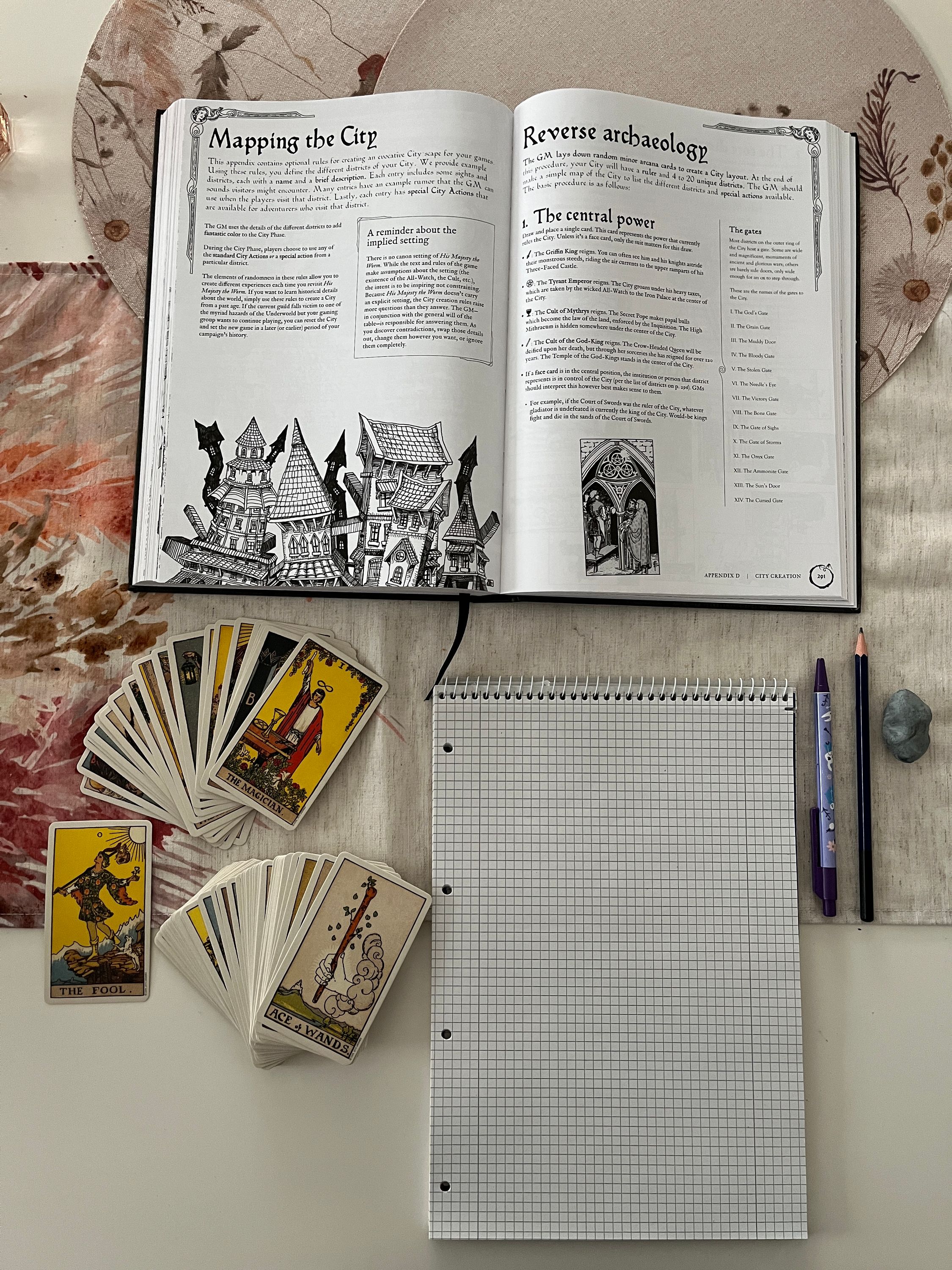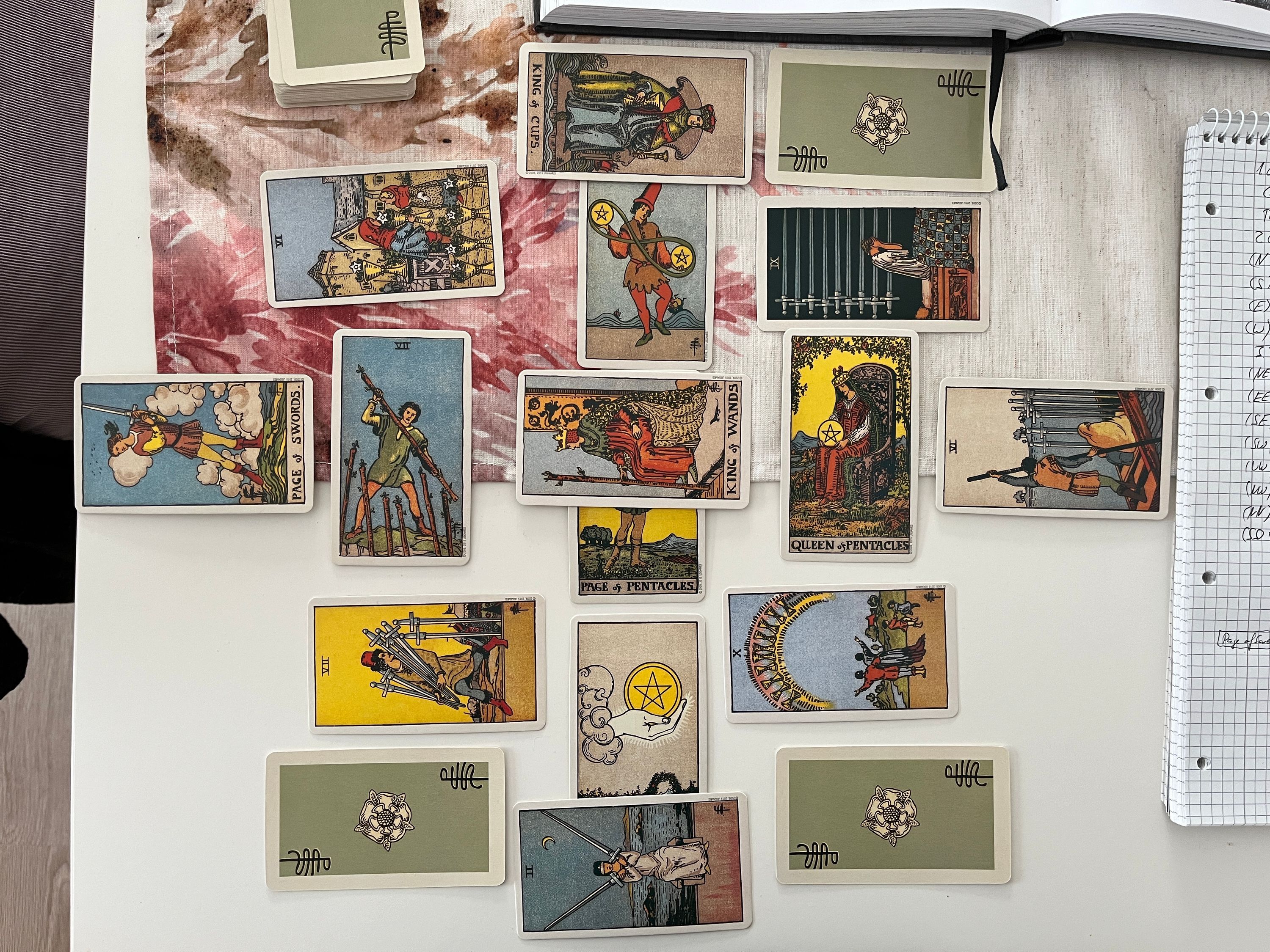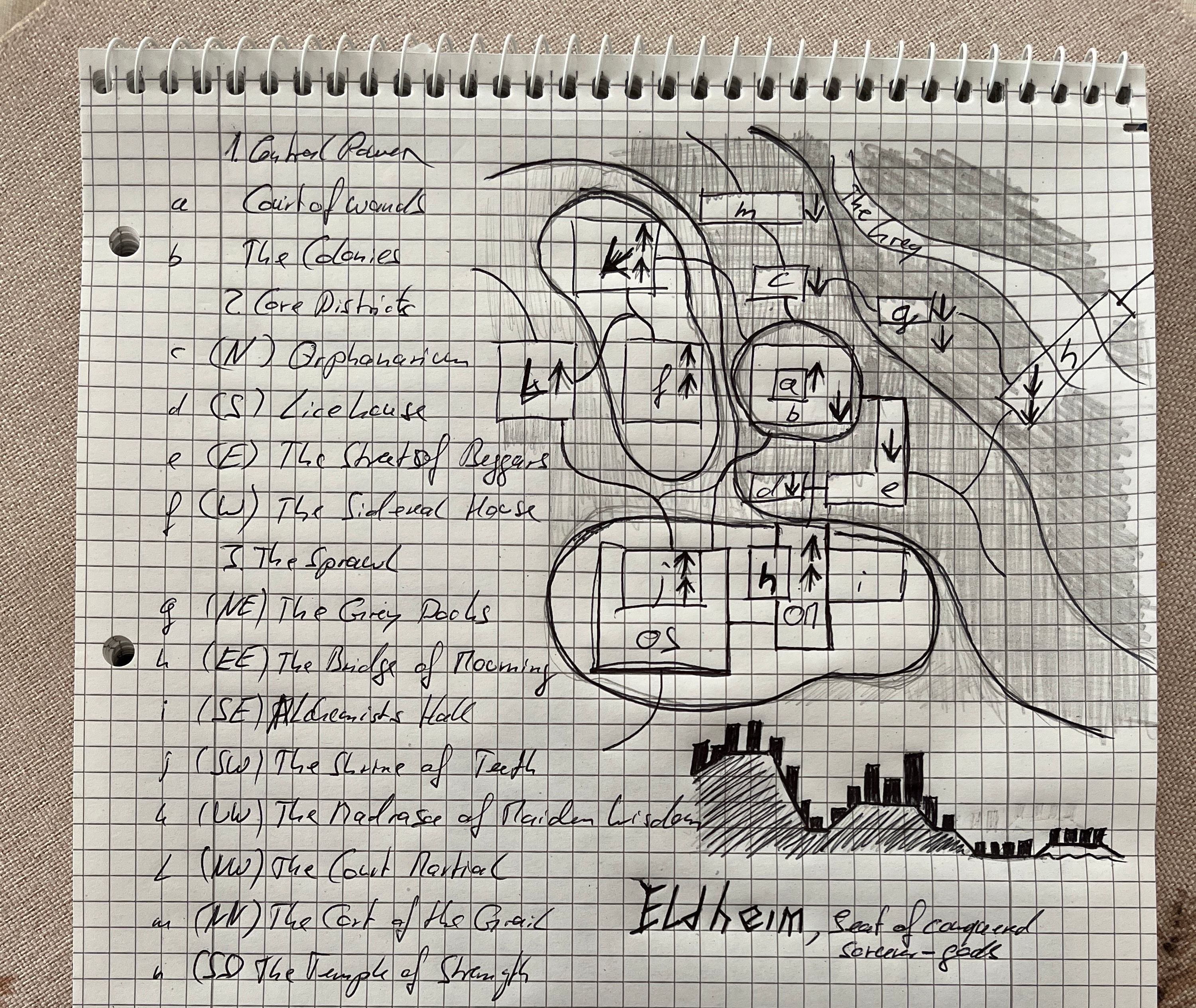Building a City with His Majesty the Worm
Last week, I was in Italy for our planned vacation and, as fate would have it, Josh McCrowell published his years-in-the-making game His Majesty the Worm via the folks from Exalted Funeral, which conveniently arrived at our doorstep on the day of our departure.
His Majesty the What?
“His Majesty the Worm is a new-school game with old-school sensibilities: the classic megadungeon experience given fresh life through a focus on the mundanities and small moments of daily life inside the dungeon.”
I’ll say upfront that I was really excited for this game release, as I’ve been reading Josh’s blog for a long time and his ideas and comments on game design resonate with my own.
I managed to read a good chunk of the 411-page tome between eating pizza and drinking coffee, and got curious to try and build a City and Underworld with the procedures laid out in the book.
Because doing it all by myself is boring, and it is a fun exercise in worldbuilding, I’ve decided to document the process in this post and take you, dear reader, along for the ride!
So buckle up, because all that we need are the book (or pdf), a deck of tarot cards and something to write on:

How to build a city using tarot cards
The city generation procedure has us drawing cards from the minor arcana to determine the core districts and surrounding areas. If the first card is a numbered card, we get the currently ruling power determined by its suit (i.e. The Tyrant Emperor for Pentacles or The Cult of Mythrys for Cups); if we draw a face card instead, it’s going to be a little more specific (we get into that in detail later on because I initially drew a face card).
We start in the middle with the ruling power, work our way outside from there and add three constant institutions (a river, catacombs and a market) at the end, leaving us with a unique city and a layout like this:

Let’s break it down and follow the procedure Josh calls “reverse archaeology”:
1. The Central Power
The first card I drew was the Page of Pentacles. According to the description, this face card represents The Colonies, an ethnic enclave of the City’s minority underfolk (the games term for dwarves, halflings and trolls) population, a place where their folkways are practiced and a diplomatic entity within the City is located.
Now, if this card is drawn while mapping the City, a special procedure tells us to draw again and place that district directly above the Colonies. My second card, thus, was The King of Wands, another face card.
The King of Wands represents The Court of Wands, an institution to control sorcerers and the impact of magic on the citizenry. According to the descrition the court is a city-within-a-city, mainly populated by sorcerers and rarely visited by others.
Both disctricts together leave us with an interesting setup with lots of potential for conflict and drama, with licensed and rogue sorcerers, witch hunts and the pitfalls of magocentric bureaucracy.
I imagine the Court as a kind of Mont-Saint-Michel-esque location: A central hill upon which the old town was build by the underfolk, with a walled-off, spire laden keep at its top. This double-district also presents us with a form of city government, a House of Lords and Commons like situation, consisting of both sorcerers and magic-critical folk.
2. The Core Districts
Next up, we draw four cards and lay them around the central card. I got the following:
North: 2 of Pentacles, representing the Orphanarium, a district populated by gangs of unsupervised children.
South: Ace of Pentacles, representing the Licehouse, the poorest district of the City.
East: Queen of Pentacles, representing the Street of Beggars, another district full of lepers, orphans and beggars.
West: 7 of Wands, representing the Sidereal House, a tower on a high hill, home to astronomers and philosophers.
Oof, this city is awful. Apparently, a lot of poor people live around the central district, while the people with money are moving literally above them. Sounds like our central hill is located next to an even bigger hill, with the natural moat being a literal gutter.
3. The Sprawl
To further map out the City, I drew another eight cards and spread them around the core districts:
North-East: 9 of Swords, representing the Grey Docks, a nest of pirates and scoundrels and the only entrance to the nearby river, The Grey.
East-East: 6 of Swords, representing the Bridge of Mourning, a giant bridge over The Grey, crowded with buildings like the Ponte Vecchio in Florence and one of the main city exits. Maybe it’s even trying to close itself off, like the Kowloon Walled City.
South-East: 10 of Cups, representing the Alchemists Hall, a district full of laboratories ruled by the Order of Alchemists.
South-South: 2 of Swords, representing the Temple of Strength, a gymnasium for sports and games (I imagine it like the Colosseum in Rome).
South-West: 7 of Swords, representing the Shrine of Teeth, a defunct district of healing houses.
West-West: Page of Swords, representing the Court Martial, where trials by combat are fought out.
North-West: 6 of
Cups, representing the Madrasa of Maiden Wisdom, the local public institution of learning, offering free education.
North-North: King of Cups, representing the Court of the Grail, a temple district and seat of the Cult of Mythrys, the local religion.
This third drawing further solidifies the idea of a hill-by-the-hill topography and gives us new information about the different power players in the City.
It also adds a new and interesting question: If there’s an institution offering free education to anyone regardless of standing, why are there so many poor people seemingly left to their fate? With the Court of the Grail nearby, maybe they flock to the church for a number of reasons. Maybe they’re all of a single kith and being suppressed, like the Dalish elves from Dragon Age? This could very well develop to be a key point of a campaign.
4. Constants
Last, we place the three constant locations:
The Grey: Considering we already have the Grey Docks and the Bridge of Mourning in the northeast and east, this makes placing the river easy.
The Ossuary: The ancient catacomb beneath the City, leading down into the Underworld. I think it makes sense if we place this location beneath the Shrine of Teeth.
The Omphalic Market: The City’s center of commerce. Considering the nature of the other locations, we place it between the Temple of Strength and the Alchemist hall.
Thus, we have the following city layout:
One hill for education, law and learning;
Another hill for commerce and healthcare;
A third hill representing a governmental island;
And the gutter surrounding it, bordering The Grey.

Factions
Let’s take a look at the different groups of interest we’ve established by drawing our districts.
The Court of Wands, the governing body of the City, consisting of sorcerers and underfolk alike. Paranoid of magical mishaps, they rule from their ivory tower.
The Queen of Beggars, the democratically elected representative of the City’s smallfolk.
The Bridgertons, a small group trying to establish the Bridge of Mourning as an independent entity within the City, by force if necessary.
The Order of Alchemists, trying to consolidate their hold over mercantile power.
The Cult of Mythrys, the local church; benevolent and selfless, but pursuing their own interests.
The Astronomers of Sidereal House have foreseen the stirring of the Worm, but nobody listens to them.
The Madrasa of Maiden Wisdom provides free education to all. But have they ulterior motives?
Some of these are as likely to cooperate with others, as they are to compete with another. Sounds like we inadvertently build ourselves a powder keg with lots of potential contracts for an interested (or desperate?) guild.
What’s in a name?
Every good City needs a name, and this one is no different. I’ll jump slightly ahead at this point: When following the procedure to build the megadungeon beneath the City, we choose the origin of the Underworld and with it, a theme that we can go back to when fleshing out its contents.
With our central power, The Court of Wands, we established a general theme of “fear of magic” for this City. I picked one of the suggested origins in the book that speaks of “a heaven usurped by ancient sorcerers”, further cementing the theme, even into the depths of the earth below.
Thus, the City shall be called Eldheim, seat of conquered Sorcerer-Gods.
Next, we build the Underworld!